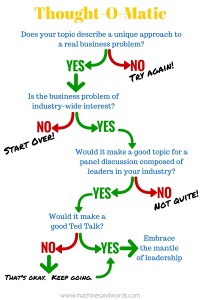Everybody wants to develop thought leadership. Companies see the value in controlling the talking points relevan t to their markets, and individuals understand that earning the epithet ‘thought leader’ will lend gravitas to their opinions at their current companies and garner publicity that will thrill recruiters when the next job search rolls around.
t to their markets, and individuals understand that earning the epithet ‘thought leader’ will lend gravitas to their opinions at their current companies and garner publicity that will thrill recruiters when the next job search rolls around.
I work with executives on their thought leadership efforts every day, and what I’ve learned is that there are plenty of very smart people who are simply not conceptual thinkers. That’s not a slam against anybody; a person doesn’t have to be a conceptual thinker to be an outstanding leader.
But these days, everybody expects executives to churn out brilliant ideas like they were widgets. That’s not an easy task for anybody, let alone busy people who are pulled in many directions at once.
To shift from a pragmatic focus on product features or measurable results, a person needs to think about causes that have led us to the point we’re at now and about trends that will drive us to where we’re going next. We’re not necessarily bent on providing answers; after all, a thought leader isn’t a fortune teller. We are aiming to ask the right questions—a thought leader is an observer, a translator, and sometimes an evangelist.
Real thought leadership shows an evolution of ideas, and that takes time and planning. The what’s on my mind this week approach that people often fall back on results in a smorgasbord of disjointed ideas. Some may be memorable and most will not, but either way, nobody’s going to associate them with their creator because they don’t present a cohesive chain of thought. A focus is needed.
If you’re stuck for an idea, try starting with a single broad topic and then work your way in over time. So begin with a big idea and write an overview of it. Then break the big idea into smaller pieces and explore each one in depth, always tying it to a strategic cause or trend. If the material is planned well, a single idea may be able to fuel a lot of content. For instance, I’m working on a project about using a specific (and unusual) methodology to solve business problems. The first piece explains what the methodology is and why it’s superior to alternative approaches; the next piece will examine why it works; and later, there could as many as eight more pieces that tie each stage of the process to a strategic benefit.
And when all those articles are completed, they can be combined into a single unit to create an ebook. They can be converted into several presentations. They can be turned into a few checklists or worksheets that can be used as lead magnets. The tactical steps can be turned into infographics. That’s efficiency.
But first, you need that good idea. So how do you tell if your idea is good enough to use in your thought leadership? Here, have a handy decider:
Jay Gito mer of Machines & Words helps companies selling complex technologies expose the real business value of their solutions and shorten their sales cycles with white papers, case studies, and slicks written in plain English. Over a decade of marketing experience in the tech industry has given her an understanding of strategy, technology, and B2B markets that translates into content that connects with your customers. Jay teaches digital marketing at the graduate level and is certified in inbound marketing by HubSpot. She is a graduate of Sarah Lawrence College and has an MA in English Literature and Creative Writing from NYU. In the cats vs. dogs debate, Jay is firmly on the side of dogs.
mer of Machines & Words helps companies selling complex technologies expose the real business value of their solutions and shorten their sales cycles with white papers, case studies, and slicks written in plain English. Over a decade of marketing experience in the tech industry has given her an understanding of strategy, technology, and B2B markets that translates into content that connects with your customers. Jay teaches digital marketing at the graduate level and is certified in inbound marketing by HubSpot. She is a graduate of Sarah Lawrence College and has an MA in English Literature and Creative Writing from NYU. In the cats vs. dogs debate, Jay is firmly on the side of dogs.

